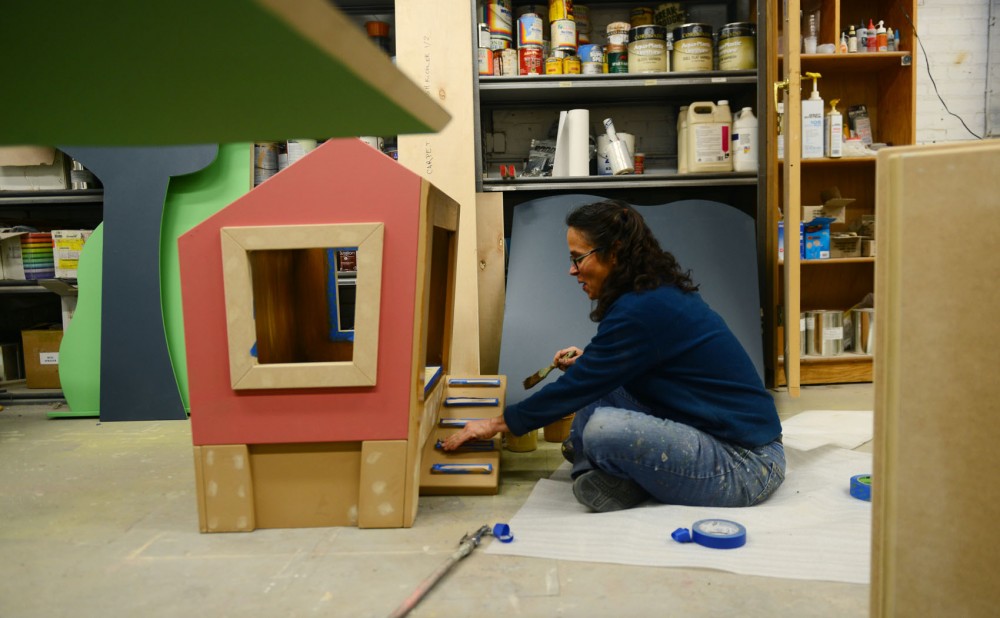There’s a hidden world of woodworking, welding and electronic wonders in a warehouse across the street from the Hexagon Bar in the Seward neighborhood.
At first look, it seems the array of equipment could be used for anything. But soon the eye catches strange sights — a red rollercoaster here, a giant Lite-Brite wall there and even the beginnings of a homemade Ferris wheel.
Welcome to KidZibits, a local business that’s been designing and constructing exhibits for museums across the United States since 2001. The 11-person team consists of welders, engineers, child development specialists, Boy Scouts and everyone in between.
KidZibits employees, including owners Jim Clark and Rob Segal, are masters of many crafts and rotate between different stations throughout the day.
“It’s pretty weird when the owner comes up and says, ‘What do you want me to do?’” shop foreman Jason Wilson said. “Anything we’re dealing with, they’re dealing with.”
Production director Dave Mink said Wilson is KidZibits’ ideal candidate: a farm kid who went to school for technical theater.
“[Exhibit work] is like putting on a show, but it’s longer-term than a theater show,” exhibit developer Rachel Moritz said.
When museums approach KidZibits, they usually present vague and open-ended concepts, like “space” or “rockets.” It’s KidZibits’ job to turn their ideas into concrete projects.
“I always think of it as 3-D journalism. You’re thinking about how to take something that’s a little bit abstract and put it in three-dimensional form,” Moritz said.
The process starts with design director Peter Quinlan, who draws an initial design for the exhibit, sometimes a year before production starts. When the museum accumulates the needed funds, KidZibits joins it for a “charette” — an intense period of design and planning.
“In two days, we try to get from ‘I want an exhibit’ to ‘This is what your exhibit is gonna look like,’” Quinlan said. “In a museum setting, that process takes two to three months.”
There’s a lot to take into account when designing a children’s museum exhibit, including which age group will be targeted, how far children’s arms can reach and what safeguards should be taken.
To answer these questions, KidZibits sometimes turns to child development specialists and other outside experts. But most of the time, the information comes straight from its target audience.
“When we have a project, we bring kids in and watch how they play, how they interact with the exhibits,” Mink said.
When a new exhibit is finished, staff members dress their kids in child-size lab coats and observe them as they interact with it so they can find and fix flaws early on.
David Mink said adults assume kids will use exhibits exactly as intended.
“[They think,] ‘We’re gonna make this thing where kids are gonna take a ball, set it here, it’s gonna roll down the track and end up here,’” Mink said. “And then you bring the kids in, and they put the ball in on the other side.”
The KidZibits environment is fully family-friendly, and that warmth shows in staff interactions. Employees eat homemade lunches together, joke about their Boy Scout backgrounds and add little speech bubbles and zombies to design sketches.
When they’re slow on business, the front-end staff and owners take time off and keep the younger employees working.
“We can afford to take a little bit of time off, and they can’t,” Quinlan said.
In terms of regular shop hours, Quinlan said staff members are required to show up to work “promptly between 8 and 10:30 in the morning.”
Lately, work has been anything but slow. KidZibits is working on a massive exhibit for Discovery Depot in Galesburg, Ill., that includes a firehouse, a fire truck, a farm, a Ferris wheel and a rollercoaster.
KidZibits sets few limitations for itself. The small company takes on new challenges, and team members spend a lot of time perfecting the work — even if that means the profit margin isn’t huge.
“Our deal is, whatever the problem is, we’ll figure it out with you,” Quinlan said. “We do that in lieu of making money, because, you know, it’s the right thing to do.”

















